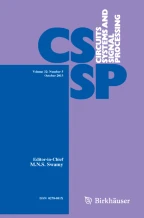Abstract
This paper considers H ∞ control of a class of switching nonlinear systems with time-varying delays via T–S fuzzy model based on piecewise fuzzy weighting-dependent Lyapunov–Krasovskii functionals (PFLKFs). The systems are switching among several nonlinear systems. The Takagi and Sugeno (T–S) fuzzy model is employed to approximate the sub-nonlinear dynamic systems. Thus, with two level functions, namely, crisp switching functions and local fuzzy weighting functions, we introduce a continuous-time switched fuzzy systems, which inherently contain the features of the switched hybrid systems and T–S fuzzy systems. Average dwell-time approach and PFLKFs methods are utilized for the stability analysis and controller design, and with free fuzzy weighting matrix scheme. Switching and control laws are obtained such that the H ∞ performance is satisfied. The conditions of stability and the control laws are given in the form of LMIs which can be obtained by solving a set of linear matrix inequalities (LMIs) that are numerically feasible. A numerical example and the control of an uncertain radio-controlled (R/C) hovercraft with time-varying delay are given to demonstrate the efficiency of the proposed method.
Similar content being viewed by others
References
M.S. Branicky, J.H. David, Switched Linear Systems Control and Design (Springer, New York, 2004)
D.J. Choi, P. Park, Guaranteed cost controller design for disrete-time switching fuzzy systems. IEEE Trans. Syst. Man Cybern., Part B, Cybern. 34(1), 13–23 (2004)
G. Feng, A survey on analysis and design of model-based fuzzy control systems. IEEE Trans. Fuzzy Syst. 14(5), 676–697 (2006)
G. Feng, C.L. Chen, D. Song, Y. Zhou, H ∞ controller synthesis of fuzzy dynamic systems based on piecewise Lyapunov functions and bilinear matrix inequalities. IEEE Trans. Fuzzy Syst. 13(1), 94–103 (2003)
X.P. Guan, C.L. Chen, Delay-dependent guaranteed cost control for T–S fuzzy systems with delays. IEEE Trans. Fuzzy Syst. 12(2), 236–248 (2004)
C.P. Huang, Model based fuzzy control with affine T–S delayed models applied to nonlinear systems. Int. J. Innov. Comput. Inf. Control 8(5), 2979–2993 (2012)
Q.K. Li, J. Zhao, X.J. Liu, G.M. Dimirovski, Observer-based tracking control for switched linear systems with time-varying delay. Int. J. Robust Nonlinear Control 21, 309–327 (2011)
H.Y. Li, B. Chen, Q. Zhou, W.Y. Qian, Robust stability for uncertain delayed fuzzy hopfield neural networks with markovian jumping parameters. IEEE Trans. Syst. Man Cybern. 39(1), 94–102 (2009)
H.Y. Li, H.H. Liu, H.J. Gao, P. Shi, Reliable fuzzy control for active suspension systems with actuator delay and fault. IEEE Trans. Fuzzy Syst. 20(2), 342–357 (2012)
D. Liberzon, Switching in Systems and Control (Birkhauser, Boston, 2003)
C.D. Persis, R.D. Santis, A.S. Morse, Switched nonlinear systems with state-dependent dwell-time. Syst. Control Lett. 50(4), 291–302 (2003)
I.R. Petersen, A stabilization algorithm for a class of uncertain linear systems. Syst. Control Lett. 8, 351–357 (1987)
X. Su, P. Shi, L. Wu, Y.D. Shi, A novel approach to filter design for T–S fuzzy discrete-time systems with time-varying delay. IEEE Trans. Fuzzy Syst. 20(2), 1114–1129 (2012). doi:10.1109/TFUZZ.2012.2196522
X.M. Sun, J. Zhao, J.H. David, Stability and L 2-gain analysis for switched delay systems: a delay-dependent method. Automatica 42, 1769–1774 (2006)
T. Takagi, M. Sugeno, Fuzzy identification of systems and its application to modeling and control. IEEE Trans. Syst. Man Cybern. 15(11), 116–132 (1985)
K. Tanaka, T. Hori, H.O. Wang, A multiple Lyapunov function approach to stabilization of fuzzy control systems. IEEE Trans. Fuzzy Syst. 11(4), 582–589 (2003)
K. Tanaka, M. Iwasaki, H.O. Wang, Switching control of an R/C Hovercraft: stabilization and smooth switching. IEEE Trans. Syst. Man Cybern., Part B, Cybern. 31(6), 13–23 (2001)
L. Wang, G. Feng, Piecewise H ∞ controller design of discrete time fuzzy systems. IEEE Trans. Syst. Man Cybern., Part B, Cybern. 34(1), 682–686 (2004)
H.O. Wang, K. Tanaka, M.F. Griffin, An approach to fuzzy control of nonlinear systems: stability and design issues. IEEE Trans. Fuzzy Syst. 4(1), 14–23 (1996)
L. Wang, W.X. Zheng, On H ∞ model reduction of continuous time-delay switched systems, in Proceedings of the IEEE, (2007), pp. 405–410
L. Wu, J. Lam, Sliding mode control of switched hybrid systems with time-varying delay. Int. J. Adapt. Control Signal Process. 22, 909–931 (2008)
L. Wu, X. Su, P. Shi, Model approximation for discrete-time state-delay systems in the T–S fuzzy framework. IEEE Trans. Fuzzy Syst. 19(2), 366–378 (2011)
L. Wu, X. Su, P. Shi, J. Qiu, A new approach to stability analysis and stabilization of discrete-time T–S fuzzy time-varying delay systems. IEEE Trans. Syst. Man Cybern., Part B, Cybern. 41(1), 273–286 (2011)
G.H. Yang, J. Dong, Switching fuzzy dynamic output feedback H ∞ control for nonlinear systems. IEEE Trans. Syst. Man Cybern., Part B, Cybern. 40(2), 682–686 (2010)
L. Zhang, P. Shi, Stability, l 2-gain and asynchronous control of discrete-time switched systems with average dwell time. IEEE Trans. Syst. Man Cybern., Part B, Cybern. 40(2), 682–686 (2010)
X. Zhang, Z. Zhang, G. Lu, Fault detection for state-delay fuzzy systems subject to random communication delay. Int. J. Innov. Comput. Inf. Control 8(4), 2439–2451 (2012)
Acknowledgements
The work described in this paper was partially supported partly by a grant from the National Natural Science Foundation of China (Grant No. 60904004, No. 60904061), partly by the Natural Science Foundation of Jiangsu Province (Grant NO. BK2010493), partly by the Qing Lan Project, partly by a grant from the Fundamental Research Funds for the Central Universities (Grant No. ZYGX2009J020), and partly by a grant from the Research Grants Council of the Hong Kong Special Administrative Region, China (Project No.: CityU 1353/04E).
Author information
Authors and Affiliations
Corresponding author
Rights and permissions
About this article
Cite this article
Ou, O., Mao, Y., Zhang, H. et al. Robust H ∞ Control of a Class of Switching Nonlinear Systems with Time-Varying Delay Via T–S Fuzzy Model. Circuits Syst Signal Process 33, 1411–1437 (2014). https://doi.org/10.1007/s00034-013-9702-4
Received:
Published:
Issue Date:
DOI: https://doi.org/10.1007/s00034-013-9702-4
